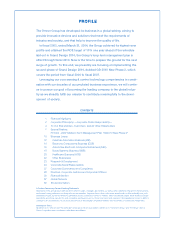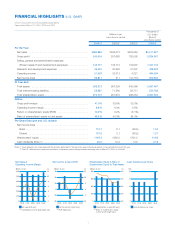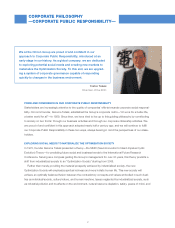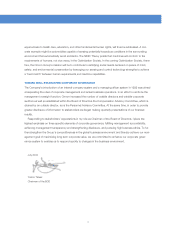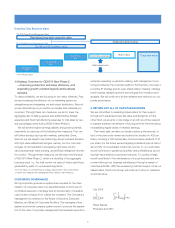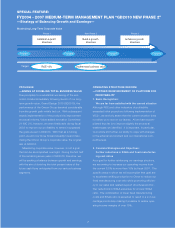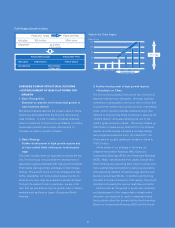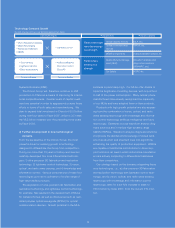Omron 2004 Annual Report Download - page 6
Download and view the complete annual report
Please find page 6 of the 2004 Omron annual report below. You can navigate through the pages in the report by either clicking on the pages listed below, or by using the keyword search tool below to find specific information within the annual report.
4
Hisao Sakuta
President and CEO
TO OUR SHAREHOLDERS, CUSTOMERS,
AND ALL OTHER STAKEHOLDERS
Our mission—to contribute meaningfully to the development of
society—is more than just an empty dream. That’s because we
have adopted a realistic approach to carrying out this mission,
effectively utilizing our accumulated managerial resources.
RETROSPECTIVE ON FISCAL 2003
1. Operating Environment
Momentum fueled by domestic private-sector capital
investment and continued growth in China
The subtle signs of recovery in the Japanese economy, which
began to emerge during the fiscal year ended March 31, 2003,
grew increasingly apparent over the course of fiscal 2003, ended
March 31, 2004. The biggest difference compared to past recov-
ery cycles is that the present upturn is not solely reliant on exports
but rather is grounded in solid domestic demand. In particular,
movement is being felt in the new growth industry of digital con-
sumer electronics, even as long-depressed private-sector capital
investment has shown impressive double-digit year-on-year growth
for the fiscal year under review.
At the same time, overseas expansion is picking up, centered on
China, where the Omron Group has prioritized business development
for some time. Currently making a transformation from the “world’s
factory” to the largest consumer market on earth, China achieved
strong real GDP growth of 9.1% during the year under review.
2. Operating Results of the Omron Group
High-value-added technology and marketing, com-
bined with aggressive overseas business development
Overall sales for fiscal 2003 outpaced our initial target by 4.4%, ris-
ing to ¥584.889 billion, a 9.3% increase over the previous year.
Our Automotive Electronic Components Business (AEC) receded
because of production cutbacks by North American automakers.
Moreover, sales in the Other Businesses segment declined due to
exclusion of a number of previously consolidated subsidiaries from
the period’s consolidated results owing to structural reforms imple-
mented prior to September 2003. Nevertheless, we could achieve
the better-than-expected results, thanks largely to strong perform-
ances by our core business segments. In addition to positive con-
ditions in the macro business environment, I believe the expansion
in sales was driven by our solid grasp of customers’ diversifying
and increasingly sophisticated requirements, which in turn guided
our development and market launch of technology-driven products
and provision of solutions to help our customers attain greater pro-
ductivity and improved quality. Specifically, we actively undertook
proposal-based sales and marketing activities focusing on the
semiconductor and flat panel display (FPD) industries, and suc-
ceeded in substantially expanding sales of such products as base
inspection systems, displacement sensors, and high-precision
control devices. In addition, sales of backlights used in cellular
phones doubled by differentiating our products in respect of lower
energy consumption and increased brightness.
Geographically, sales rose 11.0% year-on-year in Japan and
6.8% overseas. Sales in China, in particular, showed strong growth
of approximately 30%, including direct exports from Japan, which is
clearly one of the most important factors of the year under review.
Structural improvements and increased net sales yield
record profits
Operating income jumped 59.1% year-on-year to ¥51.403 billion,
while net income soared by a factor of over 52.5 to ¥26.811 billion,
both record highs. These figures exceeded our initial targets by
19.5% and 41.1%, respectively.
Our proactive stance for strengthening our technological edge
and new market development resulted in increase in expense by
¥13.4 billion during the year. Nevertheless, this was more than off-
set by the positive effects of an increase in net sales (¥22.2 billion)
and productivity gains (¥10.2 billion). Productivity gains were the
fruits of our Value-added Innovation Committee 21 (VIC21) struc-
tural reforms, launched in fiscal 2001, which served to accelerate
reductions in variable costs and fixed manufacturing costs.
Return on shareholder’s equity (ROE) jumped from 0.2% to
10.2%, thus reaching a year ahead of schedule the 10% target set
out in VIC21. In short, I would summarize the year’s achievements
by noting that we succeeded in establishing a solid platform for the
next stage of growth.


